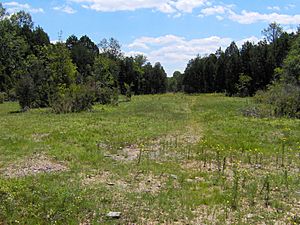Leavenworthia crassa facts for kids
Quick facts for kids Leavenworthia crassa |
|
|---|---|
| Conservation status | |
| Scientific classification | |
| Genus: |
Leavenworthia
|
| Species: |
crassa
|
The Leavenworthia crassa, also known as the fleshy-fruit gladecress, is a special kind of flowering plant. It belongs to the Brassicaceae family, which includes plants like cabbage. This plant is found only in Alabama, United States, in just two counties. It is considered one of the most endangered plants in the Southeast. Because of this, the United States Fish and Wildlife Service officially listed it as an endangered species in 2014. This means it is in great danger of disappearing forever.
Contents
What Does It Look Like?
This plant can look different from one plant to another. How it looks is mostly decided by its genes, not so much by where it grows. This is because of how the plant reproduces. Some plants need pollen from other plants to make seeds. This is called being self-incompatible. Other plants can fertilize themselves, which is called self-fertilizing.
In some groups of these plants, you can find both types. But in other groups, almost all the plants can fertilize themselves.
- Self-incompatible plants: These plants have larger, sweet-smelling flowers. Their pollen-producing parts (called anthers) face outwards. This helps them share pollen with other plants. These plants can have white or yellow flowers.
- Self-fertilizing plants: These plants have smaller flowers that don't smell much. Their anthers face inwards.
This plant is an annual herb, meaning it lives for only one year. It usually grows a circle of leaves close to the ground, called a rosette. It often doesn't have a main stem.
Plant Parts
The flowers grow on long stalks, called pedicels. These stalks come out from small leaves hidden in the rosette. If conditions are good, the plant might later grow a stem with a cluster of flowers.
- Leaves: The leaves can be up to 8 centimeters long. They have one to eight rounded parts on each side, with the biggest part at the tip. The edges of the leaves can be smooth or have small teeth.
- Flowers: The flower stalks are 4 to 8 centimeters long. Each flower has 4 petals, about 1 to 1.4 centimeters long. Each petal has a small notch at its tip. The petals can be white or yellow, but all of them have yellow or orange bases.
- Fruit and Seeds: The fruit is smooth and shaped like a small, rounded pod, up to about 1.4 centimeters long. This pod holds the seeds. The seeds are winged and are about 2 or 3 millimeters long.
Where Does It Live?
Like other plants in its small group, Leavenworthia crassa lives in a special place called a cedar glade. These glades are sunny, open areas found in forests. These forests are mostly made up of eastern red cedar trees.
Cedar glades have very thin soil over layers of limestone rock. You can see many bare rocks and gravel patches. The soil gets very wet in winter and spring, but it becomes very dry in the summer. This plant needs lots of sunshine from these open areas. It cannot grow in shady spots.
Other plants that live in these unique glades include:
- Tennessee milkvetch
- Alabama gladecress
- Michaux's gladecress
- dwarf larkspur
- smooth rockcress
- yellow sunnybell
- small skullcap
Pollination
Plants that need pollen from other plants are likely pollinated by small bees. These bees are often from the halictid bee family, like the Halictus ligatus bee. They help carry pollen from one flower to another.
Protecting This Plant
This plant grows in only six small spots in Lawrence and Morgan Counties in northern Alabama. These spots are all within about 13 miles of each other. Some groups of these plants are very small, but in other areas, there are many of them. In 2009, there were about 12,000 individual plants in total.
Most of the places where this plant grows are on private land. However, one spot is in a protected area within the William B. Bankhead National Forest.
Threats to Its Home
The biggest danger to Leavenworthia crassa is the loss and damage of its cedar glade home. About half of the cedar glades in this region have been lost since people from Europe first settled there. The remaining glades are now broken into smaller pieces. They are also changed by things like:
- Animals eating the plants (grazing)
- Farming
- Building homes and other buildings
Many glades are also affected by activities near roads. This includes herbicides (weed killers), road building, leveling the ground, trash dumping, and off-road vehicles.
When glades are changed, they can't stay open and sunny on their own. Normally, things like drought, wildfire, and erosion help keep them open. But without these natural processes, woody plants start to grow in and make the glades smaller. This reduces the sunny spots that the fleshy-fruit gladecress needs to survive.
This problem gets worse because of invasive species of plants. These are plants that are not native to the area and grow very fast, taking over. Two examples are common privet and bush honeysuckle. They quickly fill in the open spaces.
The plant was listed as an endangered species because it is "in danger of extinction throughout all or a significant portion of its range." This means it could disappear forever if we don't protect its habitat.



